Cocreated Projects Worth Doing
An inclusive collaborative approach for design of strategic initiatives in VUCA
Keywords:
Cocreation, Project, Knowledge, Decision-making, Leadership, Sustainability, VUCAAbstract
The fact that an unpredictable event like the COVID Pandemic can disable humanity’s significant structures (social, economic and political), demonstrates just how vulnerable that system is. Our systems are running on the brink of sustainability to optimise efficiency and making it quite fragile. We can create a more resilient and adaptable system, if we challenge ourselves to do things differently and invest our collective knowledge in more sustainable approaches. To achieve such desired outcomes, we will benefit from adopting more cocreative approaches for the design and implementation of strategic change. One effective tool for this purpose is “ Cocreated Project Worth Doing” (CPWD). This article describes what CPWD are, where they evolved from, and why they have greater agility and impact than traditional project methods in uncertainty. This article acknowledges that there is value in maintaining a diversity of approaches to project design and implementation. CPWD does not replace traditional project management (PM) design and implementation methods, it adds to our PM toolkit, especially in VUCA situations (Volatile, Uncertain, Complex and Ambiguous).aThe fact that an unpredictable event like the COVID Pandemic can disable humanity’s significant structures (social, economic and political), demonstrates just how vulnerable that system is. Our systems are running on the brink of sustainability to optimise efficiency and making it quite fragile. We can create a more resilient and adaptable system, if we challenge ourselves to do things differently and invest our collective knowledge in more sustainable approaches. To achieve such desired outcomes, we will benefit from adopting more cocreative approaches for the design and implementation of strategic change. One effective tool for this purpose is “ Cocreated Project Worth Doing” (CPWD). This article describes what CPWD are, where they evolved from, and why they have greater agility and impact than traditional project methods in uncertainty. This article acknowledges that there is value in maintaining a diversity of approaches to project design and implementation. CPWD does not replace traditional project management (PM) design and implementation methods, it adds to our PM toolkit, especially in VUCA situations (Volatile, Uncertain, Complex and Ambiguous).The fact that an unpredictable event like the COVID Pandemic can disable humanity’s significant structures (social, economic and political), demonstrates just how vulnerable that system is. Our systems are running on the brink of sustainability to optimise efficiency and making it quite fragile. We can create a more resilient and adaptable system, if we challenge ourselves to do things differently and invest our collective knowledge in more sustainable approaches. To achieve such desired outcomes, we will benefit from adopting more cocreative approaches for the design and implementation of strategic change. One effective tool for this purpose is “ Cocreated Project Worth Doing” (CPWD). This article describes what CPWD are, where they evolved from, and why they have greater agility and impact than traditional project methods in uncertainty. This article acknowledges that there is value in maintaining a diversity of approaches to project design and implementation. CPWD does not replace traditional project management (PM) design and implementation methods, it adds to our PM toolkit, especially in VUCA situations (Volatile, Uncertain, Complex and Ambiguous).
Warning: file_put_contents(): Only -1 of 23 bytes written, possibly out of free disk space in /home2/openjtg/public_html/lib/pkp/classes/cache/FileCache.inc.php on line 90
References
BENNET A, BENNET D, SHELLEY A, BULLARD T and LEWIS J 2017 The Intelligent Social Change Journey.
VINE Journal of Information and Knowledge Management Systems Vol.47(2) 265-300.
Crawford, L, Morris, P, Thomas, J & Winter, M 2006, Practitioner development: From trained
technicians to reflective practitioners. International Journal of Project Management , vol. 24, no. 8,
pp. 722-33.
Christensen, CM 2015 The Innovator's Dilemma. When New Technologies Cause Great Firms to Fail.
Harvard Business Review Press.
CREATIVE MELBOURNE 2019 Where Creativity Meets Business to Connect, Explore, Design and Cocreate in a social learning experience. http://www.creativemelbourne.com.au/ Accessed April 20, 2020.
DODGE H 2020 My Meteorite. Or, Without The Random There Can Be No New Thing . Random House.
LEAVY, B 2005, A leader's guide to creating an innovation culture. Strategy & Leadership , vol. 33, no. 4, pp. 38-45.
Liedtka, J., King, A., & Bennett, K. (2013). Solving Problems with Design Thinking. Ten Stories of What Works . New York, NY: Columbia University Press.
SHELLEY AW 2017 KNOWledge SUCCESSion . Sustained performance and capability through knowledge projects. Business Expert Press. Project Management Series.
SHELLEY AW 2018 Leading Knowledge Flows and CoCreation for Sustained Future Outcomes . Chapter 10
in Knowledge Management Matters. Editors John and JoAnn Girard. Sageology.
SHELLEY AW and GOODWIN D 2018 Optimising learning outcomes through social co-creation of new knowledge in real-life client challenges. Journal Applied Learning and Teaching. Vol.1(2) 26-37.
SNOWDEN D and BOONE M 2007, 'A leader’s framework for decision making', Harvard Business Review , November, 68-76.
TALEB NN 2013 Antifragile. Things that gain from disorder. Penguin.
Published
How to Cite
Issue
Section
Copyright (c) 2020 Arthur Shelley

This work is licensed under a Creative Commons Attribution 4.0 International License.
Published in Journal of Technology & Governance. Published by Creactos Projects (OPC) Private Limited. This article is published under the Creative Commons Attribution (CC BY 4.0) license. Anyone may reproduce, distribute, translate and create derivative works of this article (for both commercial and non-commercial purposes), subject to full attribution to the original publication and authors. The full terms of this license may be seen at http://creativecommons.org/licences/by/4.0/legalcode


